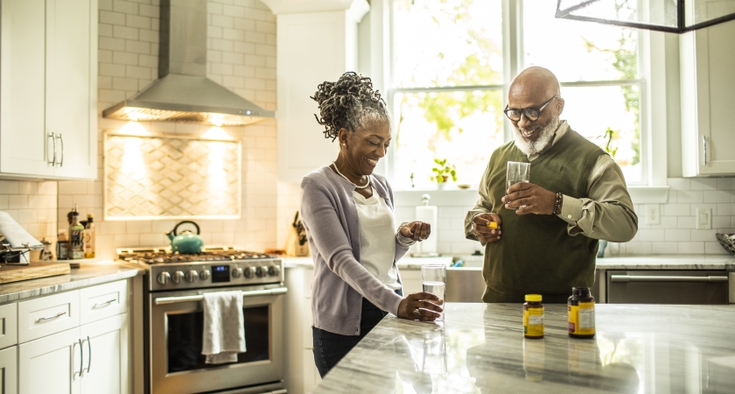As a colorectal surgeon, he talks about – and treats – “bathroom problems.” He treats conditions such as inflammatory bowel disease, anorectal (anus and rectum) disorders and colon and rectal cancer, among others. He’s trained in using the da Vinci robot for surgery, but we talked to him about something much more basic. One of the most common issues he treats is something nearly everyone suffers from at one time or another – constipation.
He and his family – including his wife, who’s an infectious disease doctor – recently moved to Wilmington from Orlando when he joined Novant Health General Surgery - New Hanover (Colon & Rectal). We talked to him about a common problem people are often embarrassed to acknowledge.
Personalized, private care you deserve.
What’s the first thing should people know about colon health?
Maintaining good colon health starts with diet. We all need to eat at least 25 grams of fiber a day. There are many ways to consume fiber – certain breakfast cereals, vegetables and fiber supplements. I personally eat high-fiber cereals and take fiber supplements.
We also need to drink around 68 ounces of water a day, which comes out to around six to eight 8-ounce glasses. And that’s pure, unadulterated water. Drinks with caffeine do not count.
Even people who eat plenty of vegetables can still have GI issues related to their colons. So, fiber supplements like Metamucil and Benefiber are a good idea for every adult. They don’t come with any contraindications, and they’re useful for bulking up stool and keeping water in. There’s no reason not to take fiber. (A contraindication is a reason someone should not take something because of their health or other factors.)
What exactly is constipation?
Simply, constipation is when you have to strain to have a bowel movement. And it’s important to note that the frequency with which people have BMs varies from one person to the next. Everyone’s normal can be different. Normal can range from once or twice a day to once every two or three days. When you’re constipated, your BMs may be hard, lumpy and require straining.
Are there any risks of being constipated?
The risks of remaining constipated include pain, bloating and discomfort. Constipation can be secondary to a diet low in fiber, not drinking enough water or side effects of medications.
If you remain constipated for a prolonged period, it’s a good idea to contact your primary care provider. They’ll likely recommend adding more fiber to your diet or taking a supplement. And if the problem still persists, they may refer you to a specialist.
Constipation might seem trivial, but it can get pretty involved. There are different types and different reasons why people have it.
Functional constipation is a problem intrinsic to the colon; it has to do with physiology. It’s when the colon doesn’t work optimally, and it may require medicine or surgery. Functional constipation is a problem that’s not caused by something else like diet or medication.
Obstructive defecation is when you can’t empty your bowels properly. It’s characterized by straining, unproductive urges to empty your bowels, not being able to empty your bowels completely. It’s most common in postpartum women who had a vaginal delivery.
Is travel constipation a real thing? I know people – and I may be including myself here – who have a hard time going when out of town.
It’s definitely a phenomenon. Using a stool softener (such as Colace) is a good first step. I recommend packing a stool softener whenever you’re traveling. If others fail, try MiraLAX. That is the same medication that what we give – by another name (polyethylene glycol) and at a much higher dose – to people preparing for colonoscopies.
I imagine people often wait to see a doctor about constipation because they’re embarrassed to talk about their BMs.
I think that’s probably true. But if you wait too long and continue to strain, you could develop hemorrhoids.
Hemorrhoids are actually a normal part of everyone’s anatomy. They’re blood vessels lining our anal canals that help us maintain continence. They “hold things in,” in other words. So, when people say they “have hemorrhoids,” it’s a misnomer. We all have them. What they mean is that they have irritated, enlarged hemorrhoids. It’s when they’re enlarged that they pose a problem.
Pregnant women frequently get enlarged hemorrhoids due to constipation and the pressure the growing fetus puts on the pelvis, which blocks blood flow.
What do you do to treat them?
The first-line treatment is improving your bowel movements through diet and improving toileting habits. Your hemorrhoids are essentially reflective of your bowel movements.
The most common over-the-counter remedy, Preparation H, is a good option in the short-term. It’s a steroid with a numbing agent in it. But if used for more than a week at a time, it can cause thinning and breakdown of the skin.
What if they haven’t cleared up after a week? Do you need to see a doctor? And if so, what will that appointment entail?
At that point, it is a good idea to see a specialist – either a gastroenterologist or a colorectal surgeon. That appointment will probably begin with a rectal exam – which people often want to avoid, so they delay making that appointment. Not every case of hemorrhoids requires surgery, though. We begin with improving diet and toileting habits.
And if those don’t work, we talk about next steps.
You mentioned toileting habits. I don’t think I know the difference between good and bad toileting habits.
You shouldn’t be on the toilet for longer than five minutes. Straining for longer than that predisposes you to hemorrhoids.
Don’t have a TV in your bathroom at home. Don’t take your cell phone, magazines or a newspaper into the bathroom with you. It’s too easy to lose track of time.
My family recently moved to Wilmington, and our house had a built-in magazine rack in one of the bathrooms. One of the first things I did was have it removed.
Now, let’s talk about those next steps you alluded to.
First, there are two types of hemorrhoids – internal and external. If the external ones are bothersome, we cut those out surgically.
For internal ones, there are less invasive procedures. There are office-based procedures, such as infrared photocoagulation (a procedure in which heat created by an infrared light creates scar tissue, cutting off blood supply to the hemorrhoid), sclerotherapy (a minimally invasive injection) and – the most common one – rubber band ligation. That’s where the doctor wraps a rubber band around the base of the problem hemorrhoid – which isn’t painful – and it falls off about five days later. There’s no need for anesthesia, and patients can go back to work right after the procedure.
If diet and Preparation H don’t work – and you can’t get in with your doctor right away – try a sitz bath for the discomfort. (It won’t take care of the problem, but it should help alleviate the pain.) You can buy a plastic basin you put on the toilet seat, but that really isn’t necessary. Sitting in a hot bath will have the same effect. I’m often asked if Epsom salts are necessary, and they’re not. It’s the hot water that relieves the pain, swelling and spasms.
If all other remedies fail, there’s always surgery. It’s a common procedure performed under anesthesia. But the patient has some responsibility to ensure the problem doesn’t return. If you don’t alter your diet after surgery, hemorrhoids will come back.
El doctor te verá ahora
A little more about Dr. Whiyie Sang
That Spanish headline translates as “The doctor will see you now.” And Sang is seeing patients in Wilmington. He grew up in Puerto Rico, speaks fluent Spanish and is particularly passionate about serving the Latino community.
Growing up in Puerto Rico, Sang said he was “living as a minority in a minority population.” His dad is Chinese and his mom is an American who’s originally from Boston. “I view my race as a mix of Asian and white, but I consider my ethnicity to be the culture I grew up in – Hispanic Latino.”
As a kid and teen, he went to school with people from all walks of life – an experience that has been beneficial to him as a physician. He said it’s a great feeling when he can help someone with poor health literacy – a condition he said is greatly affected by language barriers.
At 14, he had a rare opportunity that led to his interest in medicine. He shadowed doctors at a hospital in the Dominican Republic, where he observed surgeries and translated for patients who didn’t speak English. He came to the continental United States – North Carolina, specifically – for college at Wake Forest University and returned to Puerto Rico for medical school.
He enjoys providing care to all his patients, but knows that Spanish-speaking Latinos in America don’t often find a doctor who can readily communicate with them. He said, “You notice an immediate sigh of relief when the patient realizes you can speak their language.”













